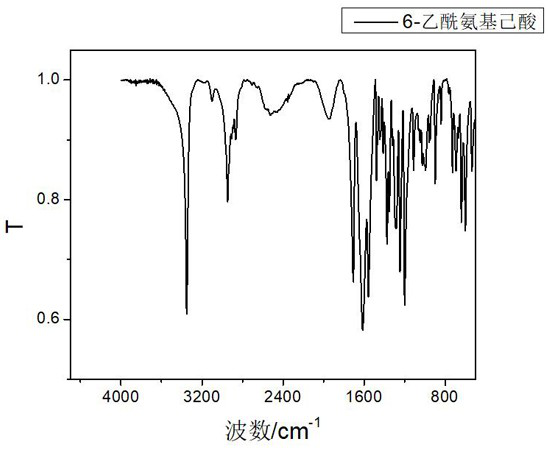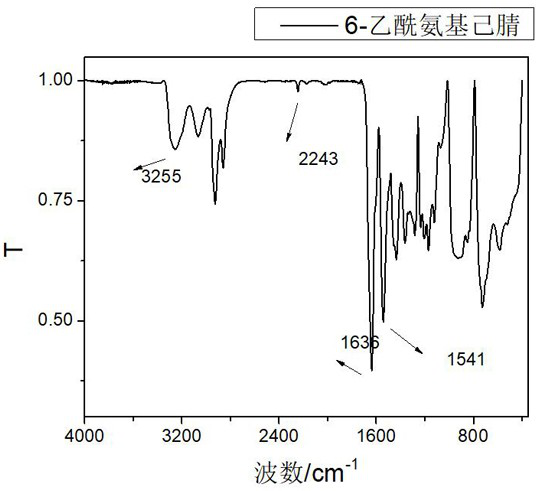A kind of method that takes caprolactam as raw material to synthesize hexamethylene diamine
A technology of caprolactam and hexamethylene diamine, which is applied in the preparation of carboxylic acid amides, chemical instruments and methods, preparation of organic compounds, etc. Equipment requirements are easy, post-processing is convenient, and the reaction conditions are mild.
- Summary
- Abstract
- Description
- Claims
- Application Information
AI Technical Summary
Problems solved by technology
Method used
Image
Examples
Embodiment 1
[0031] A method for synthesizing hexamethylene diamine with caprolactam as a raw material, comprising the following steps:
[0032] 1) Add 10g of caprolactam into a 250ml single-neck bottle, add 11g of sodium hydroxide and 25ml of water, reflux at 130°C for 3 hours and then cool to room temperature to obtain 6-aminocaproic sodium salt; the molar ratio of the caprolactam to sodium hydroxide is about is 1:3; the molar ratio of caprolactam to the amount of water added is 1:15.8;
[0033] 2) then add 9ml acetic anhydride (amino protecting group, the amount of amino protecting group is 1 times of caprolactam equivalent) in the single-necked bottle of step 1), then to 47 ℃, add concentrated hydrochloric acid after stirring reaction for 2 hours to adjust The pH value of the solution is at 2, and the precipitated solid is recrystallized with water to obtain 6-acetamidocaproic acid;
[0034] 3) drying the product of step 2) to obtain 12g solid; get the product after drying 5g and 0.15...
Embodiment 2
[0037] A method for synthesizing hexamethylene diamine with caprolactam as a raw material, comprising the following steps:
[0038] 1) Add 10g of caprolactam into a 250ml single-neck bottle, and add 13g of sodium tert-butoxide and 32ml of water, reflux at 150° C. for 2 hours and then cool to room temperature to obtain 6-aminocaproic sodium salt; the moles of caprolactam and sodium tert-butoxide are obtained. The ratio is about 1:1.5; the molar ratio of caprolactam to the amount of added water is 1:20;
[0039]2) Then slowly add 18ml benzyl chloroformate (the amino protecting group, the amount of the amino protecting group is 1.5 times the caprolactam equivalent) into the single-necked bottle of step 1), and add to the reaction solution after stirring for 2 h at room temperature. 30ml diethyl ether was used to extract the by-products in the reaction, repeat the operation twice, then add concentrated hydrochloric acid to the extracted aqueous layer solution under ice bath to adj...
Embodiment 3
[0043] A method for synthesizing hexamethylene diamine with caprolactam as a raw material, comprising the following steps:
[0044] 1) Add 10g of caprolactam into a 250ml single-neck bottle, add 7g of sodium hydroxide and 16ml of water, reflux at 100°C for 4h and then cool to room temperature to obtain 6-aminocaproic sodium salt; the molar ratio of the caprolactam to sodium hydroxide is about is 1:2; the molar ratio of caprolactam to the amount of water added is 1:10;
[0045] 2) Then slowly add 15ml of tetrahydrofuran and 20ml of benzyl chloride (the amino protecting group, the amount of the amino protecting group is 2 times the equivalent of caprolactam) into the single-necked bottle of step 1), react under reflux at 70°C for 10h, and cool to room temperature , and concentrated hydrochloric acid was added to the obtained solution to adjust the pH value of the solution to 3; after the reaction, 20 ml of ethyl acetate was added to extract the product, and the operation was rep...
PUM
 Login to View More
Login to View More Abstract
Description
Claims
Application Information
 Login to View More
Login to View More - R&D
- Intellectual Property
- Life Sciences
- Materials
- Tech Scout
- Unparalleled Data Quality
- Higher Quality Content
- 60% Fewer Hallucinations
Browse by: Latest US Patents, China's latest patents, Technical Efficacy Thesaurus, Application Domain, Technology Topic, Popular Technical Reports.
© 2025 PatSnap. All rights reserved.Legal|Privacy policy|Modern Slavery Act Transparency Statement|Sitemap|About US| Contact US: help@patsnap.com



